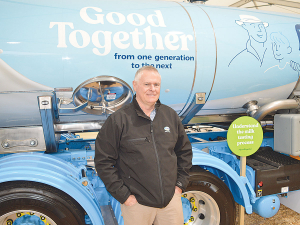Fonterra shaves 50c off forecast milk price
Fonterra has dropped its forecast milk price mid-point by 50c as a surge in global milk production is putting downward pressure on commodity prices.
 Fonterra chair Peter McBride has already been on the phone to Damien O’Connor in wake of the strong outcome of the farmer vote.
Fonterra chair Peter McBride has already been on the phone to Damien O’Connor in wake of the strong outcome of the farmer vote.
Fonterra chairman Peter McBride was immediately on the phone to Agriculture Minister Damien O'Connor after the result of last week's capital structure vote.
With Fonterra farmers voting overwhelmingly to support a new flexible shareholding structure, the co-operative now needs O'Connor's support to facilitate regulatory changes to the Dairy Industry Restructuring Act (DIRA).
O'Connor had earlier expressed reservations with the proposal. But McBride told Rural News that O'Connor was pleased with the positive outcome and the strong farmer support.
The proposal received 85.16% support among farmer shareholders. Turnout was 82.65%.
"The review process we conducted and the turnout was pretty important to the Minister," says McBride. "The strong mandate from farmers also helps."
McBride says the co-operative will now work with Ministry for Primary Industries and O'Connor's office to help prepare documents for Cabinet. A select committee hearing may also be on the cards.
Fonterra Co-operative Council chairman James Barron says farmers have clearly spoken.
"Farmers also know that Minister O'Connor has previously lent his support to farmer-owned co-operatives," he told Rural News.
The consultation process started in May and more than 5000 farmers either made online submissions or gave feedback at meetings.
McBride says he is chuffed with the result.
"It doesn't get any better than this, does it."
He says he is a bit worn out after several months of farmer meetings, but enjoyed getting to meet many shareholders.
The new flexible capital structure would reduce the number of shares farmers need to hold to join the cooperative from one share per kgMS to one share per 3kgMS.
It would also allow different type of farmer to hold shares in the company, and cap the size of the associated shareholders' fund to 10% of all shares on issue.
The changes were aimed at securing Fonterra's financial future and retaining farmers, amid the prospects of falling milk supply and competition from other milk processors that do not requires capital investment from farmers.
McBride admits he wasn't very confident at the start of the process.
"But as we clearly articulated our position on the 10-year plan and made changes to the proposal based on feedback, I grew more confident.
"Six weeks ago, I started feeling pretty confident but you are not sure until the voting results come out."
Barron says a huge amount of work has gone into the consultation process with farmers.
"Farmers are facing other challenges at the moment and this was another challenge on top of those," he says.
"But this was highly important to farmer shareholders and they engaged and provided high feedback to us."
Barron says the work on capital structure doesn't stop here.
"There's a big job ahead to get the regulatory approval needed."
OPINION: The latest reforms of local government should come as no surprise.
The avocado industry is facing an extremely challenging season with all parts of the supply chain, especially growers, being warned to prepare for any eventuality.
Rural recycling scheme Agrecovery is welcoming the Government's approval of regulations for a nationwide rural recycling scheme for agrichemicals and farm plastics.
Despite a late and unfavourable start, this year’s strawberry crop is expected to be bountiful for producer and consumer alike.
Nearly three years on from Cyclone Gabrielle, Hawke's Bay apple orchardist Paul Paynter says they are still doing remedial work around their orchards and facing financial challenges.
An unusual participant at the recent Royal A&P Show in Christchurch was a stand promoting a variety of European products, during an event that normally champions the homegrown.

OPINION: This old mutt thinks New Zealand should take a bow after winning the ‘Fossil of the Day’ award at COP30…
OPINION: The Hound reckons the argument run by the ‘agribusiness elite’ that the market will punish our exports if we don’t…